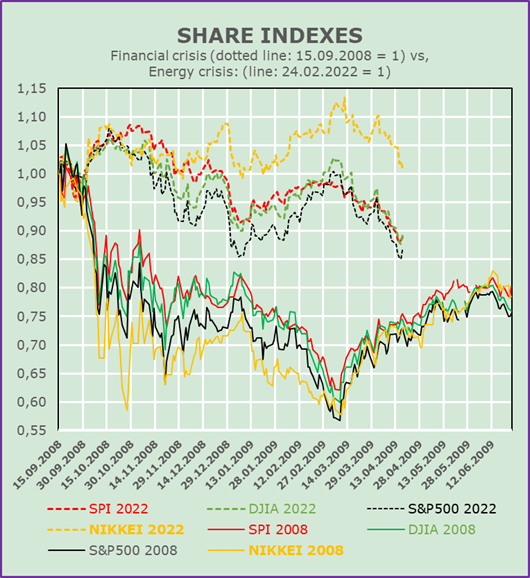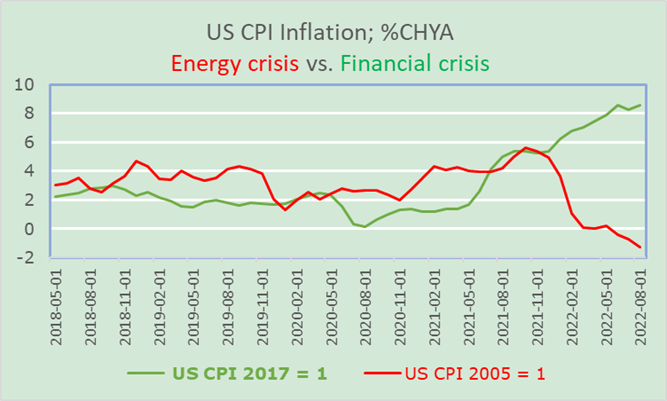EMR October 2022
Dear Reader
ENVIRONMENT
Increasingly we read and hear analysts and market participants asking the following question about the markets whereabouts: Is the 2022 energy crisis comparable to – or even more insidious than – the 2008 financial crisis?
In this context, we would like to ask the reader to closely analyze the following chart of selected stock indices. To simplify the comparison of the two periods, we have normalized the stock indices to 1 at the beginning of the respective period and superimposed them. The first period begins on 15 September 2008, the collapse of the investment bank “Lehman Brothers”, the second period on 24 February 2022, the invasion of Ukraine by the Russians.
FINANCIAL VS. ENERGY CRISIS
How did and do the stock indices react to the two states of disorder mentioned above? What does the chart suggest?

IMPLICATIONS FROM THE CHARTS
A first, summary assessment, points to differential trend movements from a one equity index to another. As each crisis perdures they become significantly less marked for the energy crisis than for the financial crisis.
A second assessment refers to the differential rates of growth, which, so far, have been significantly larger during the financial crisis than so far in the energy crisis.
A third assessment points to the shorter-term “trend reversals,” which imply a differentiated view of the actual determinants, be they inflation, interest rate policy or the ongoing war against Ukraine. In our view, these factors have determined the short-term trend much more than the longer-term one in both periods. Do they say anything about comparability? Yes, they do indeed, as we will highlight below.
Given today`s public focus on inflation, as the primary determinant, let us examine the inflation trend of the two periods, as shown in the chart on US CPI-Inflation. The chart has been comparable until July 2021, since, it has moved higher for the period of the ongoing energy crisis, while contracting in the period of the financial crisis! The real question at this crossing refers primarily to the differential interventions by the Central Banks: expansionary in the financial crisis and restrictive in the energy crisis. In addition, we should take into account that the financial crisis turned into a currency crisis as well as into a sovereign debt crisis. This setting made it easy to raise capital during the financial crisis, while making it difficult in the ensuing energy crisis.

INVESTORS` DILEMMAS
Trying to quantify the outlook based on forecasts of an impending recessionary phase, accompanied by rather persistent inflationary pressures and – for political reasons – higher interest rates, and the feared influence on financial markets and currencies, we lean toward a slightly less pessimistic assessment. There are certainly reasons why our optimism might be considered somewhat surprising and difficult to accept. Nevertheless, we believe that inflation might not be as easily reduced via higher borrowing costs. Inflation, in our assessment is determined significantly more by restrictions on the supply side than sustained demand. We would like to stress the importance of oil and gas prices as well as of food products as well as the dependence of technological components. They should fade as the Russian invasion of the Ukraine will be resolved.
In our opinion a sustained trend reversal of inflation can only take place with the end of the war against the Ukraine. This would imply a revival of international trade relations as well as an improvement in local economic activity. In addition, we expect an increasing repatriation of technological components in order to reduce – especially in Europe – the dependence on autocratic and undemocratic nations.
FINDINGS FOR INVESTORS
A closer look at the current environment reveals that the focus is on raising interest rates to counter inflationary pressures. The actual determinants of the current inflation are almost ignored. If we assume that the rise in inflation is mainly due to factors such as Covid-19, the invasion of Ukraine and China’s threat to invade Taiwan, dramatic pres-sure on the rise in crude oil, gas and food prices above and beyond normal supply and demand trends would be the consequence. So we should rather focus on how to solve the bottlenecks in the supply chains, while continuing to remain focused on the domestic market and currency.
Comments are welcome.